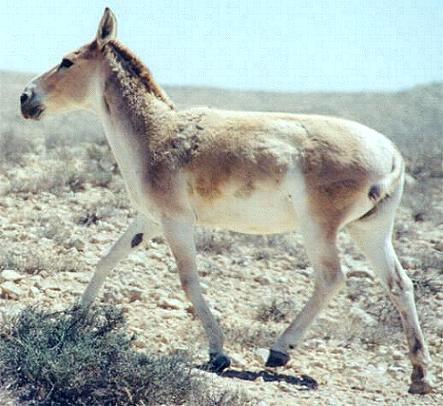
Onager in the wild near the Ramon Crater

Onager in the wild near the Ramon Crater
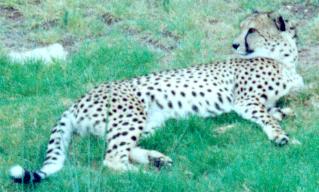 Cheetah at Jerusalem's Biblical Zoo |
In ancient times, and in the not so distant past Israel was home to many animal species which today are extinct in this region. Perhaps we humans are not so upset that predators like lions, bears, crocodiles and cheetahs no longer roam the Israeli countryside as they once did, but the disappearance of these formidable predators is part of a general decline in native species which also saw the local extinction of more docile local animals such as fallow and roe deer, Arabian oryx and the onager, a kind of wild ass. Furthermore, with the extinction or drastic decline in top-level large predators, the surviving species they prey upon have increased in some areas with no way to curb them other than hunting by humans, the very act which has already wiped out so many native large animals.
While the local Asiatic lion seems to have been eradicated by the time of the Crusades, around the thirteenth century, most of the others became extinct in the Levant region between 70-120 years ago due to the widespread use of guns and later mechanised vehicles in hunting. Some of these animals, such as the native sub-species of ostrich and onager were completely eradicated, while others only became extinct in the immediate region (Israel and neighbouring countries such as Syria, Jordan and Lebanon).
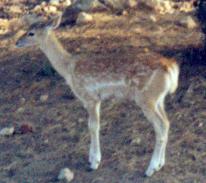 Fallow deer fawn |
Many of the less-fearsome animals which were once extinct in this region are now being reintroduced to Israel by the Hai Bar (Hebrew for wildlife) project; these include fallow deer, roe deer, the Arabian oryx, ostriches and onagers (a type of wild ass).
To the best of my knowledge there are no plans to try and reintroduce the large predators, but you can see them in captivity. The Syrian brown bear and Asiatic lion for example can be seen at Jerusalem's Biblical Zoo and crocodiles are bred at several crocodile farms around the country, such as Hamat Gaderr near the Sea of Galilee.
 Young Arabian oryx |
The Hai Bar project has several sites such as the temperate Mount Carmel forest site in northern Israel, the Yotvata site in the Arava desert in the south and part of the Biblical Zoo in Jerusalem. Their research and breeding programmes aim to return native Israeli animals to the wild, and where these animals have become extinct they try to re-introduce the most closly related sub-species or species.
The Ethiopian Ostrich is the closest surviving relative of the now extinct local ostrich, and has been bred in captivity for quite a while now at the desert Hai Bar site. A small flock has recently been released into the wild in southern Israel where their closely related Israeli sub-species once roamed.
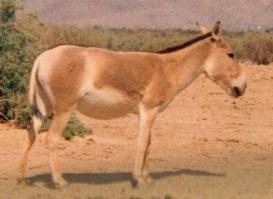 Onager (Asiatic wild ass) at the Hai Bar |
Two herds of onagers have been successfully re-introduced to the wild at two locations,Makhtesh Ramon (the Ramon Crater), a huge crater in Israel's Negev Desert, and at another site in the Arava Desert. These wild asses (the biblical pereh) were never domesticated and once inhabited all of Israel's desert regions until they were hunted to extinction between 70-80 years ago. They have also become extinct in neighbouring countries.
Today the Ramon Crater and environs are home to about 100 onagers and are often easily spotted in the area, especially close to springs and seasonal streams. One of the delights of hiking or driving in the Ramon Crater nature reserve and the nearby Negev Highlands nature reserve is the chance to see these large Israeli mammals in the wild, at home once more in the Israeli desert where they belong.
Perhaps the most striking native mammal which has been re-introduced so far is the Arabian Oryx (the biblical re'em), a black and white antelope
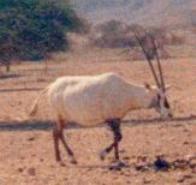 Arabian Oryx at the Hai-Bar |
Some say that the legend of the unicorn originates with the Arabian oryx. Viewed from the side its two straight horns do appear to be one horn, and it is of course white, as are most portrayals of unicorns.
With so much experience in desert conservation work the Hai-Bar is also involved in a worldwide effort to save a related species of oryx, the Saharan Oryx, which is also in danger of extinction. This species was never native to Israel, so it is only being kept at the Ha-Bar reserve and there are no plans release it into the wild in Israel.
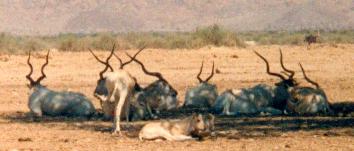 Addax at the Hai Bar, is this the biblical dishon? |
In addition to re-establishing recently extinct local species, the Hai Bar project is trying to identify native animals from the biblical period which became extinct in this region many centuries ago. Some believe that they have identified the biblical dishon antelope as the north African addax, though others dispute this. There is a herd at the Hai Bar in Yotvata but the animals will not be released into the wild in Israel unless it can be established that this really is the same animal as the dishon.
In addition the Yotvata Hai Bar sanctuary includes wild areas of this unique savannah like landscape and is home to many other native Israeli animals that still exist in the wild, including hyenas, caracals, leopards, wolves, gazelle, Blandford's, sand and fennec foxes, desert hedgehogs and many birds and reptiles. Many of these species are secretive or nocturnal, so the Hai Bar has created a special predators centre and desert night life exhibit to allow visitors to see these elusive animals up close.
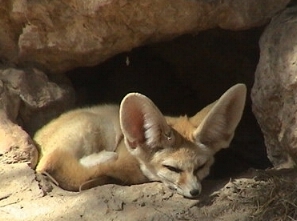 Fennec fox at the Hai Bar centre |
The Carmel forest Hai Bar is home to fallow deer (the biblical yahmor) and roe deer, (the biblical ayal). Both species were originally found in northern and central Israel, The last native roe deer was shot in 1912 in the Carmel forest while the last fallow deer in the region was hunted in neighbouring Jordan in 1922.
Persian fallow deer were brought here from Iran during the 1970s, before the Islamic revolution, at a time when Israel enjoyed close ties with Iran. With none of the local Levantine sub-species left, import was the only way to re-establish the extinct native species. Plans to re-introduce both deer species to the wild are controversial as local farmers fear that roe deer in particular will damage their crops. On the other hand roe deer are useful for managing the forest as they eat leaves and prevent the woods from becoming overgrown and impassable.
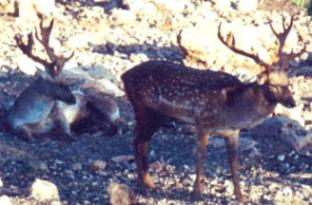 Fallow deer bucks at the Jerusalem Hai Bar |
The Carmel reserve is now home to one of the largest herds of Persian fallow deer in the world and a small number of animals were released in the western Galilee. The Odem Forest in the northern Golan Heights is also home to a deer reserve. The Carmel Hai Bar is also working in conjunction with the Rothschild Gardens in the northern town of Zikhron Ya'akov with plans to reintroduce the deer there as well.
For more information call Hai Bar Yotvata at: 08-637-3057 or 08-637-6018. If you're visiting the Eilat area be sure to visit the reserve and support their important conservation efforts.
Israeli Wildlife |
Biblical Animals |
Hai Bar Conservation Programme
Israeli Mammals |
Small Israeli Mammals |
Israeli Reptiles |
Israeli Birds |
Israeli wildlife links
Copyright 2005 by Leiah Elbaum. Text and photographs on this page are by Leiah Elbaum. Last updated 26 June 2005.